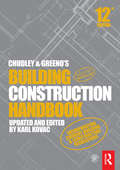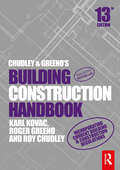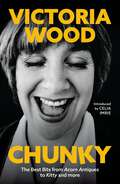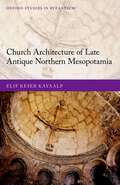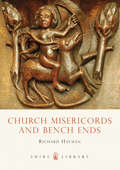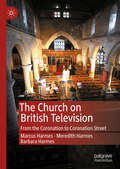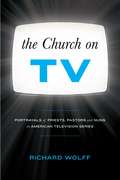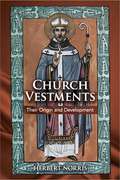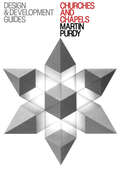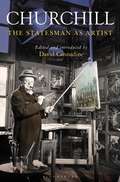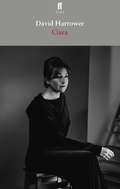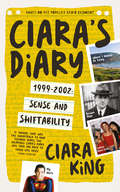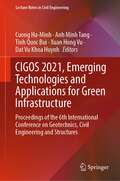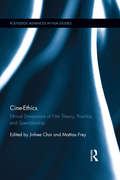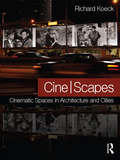- Table View
- List View
Chudley and Greeno's Building Construction Handbook
by Roy Chudley Roger Greeno Karl KovacThe 12th edition of Chudley and Greeno’s Building Construction Handbook remains THE authoritative reference for all construction students and professionals. The principles and processes of construction are explained with the concepts of design included where appropriate. Extensive coverage of building construction practice, techniques and regulations representing both traditional procedures and modern developments are included to provide the most comprehensive and easy to understand guide to building construction. This new edition has been updated to reflect recent changes to the building regulations, as well as new material on modern methods of construction, greater emphasis on sustainability and a new look interior. Chudley and Greeno’s Building Construction Handbook is the essential, easy-to-use resource for undergraduate and vocational students on a wide range of courses including NVQ and BTEC National, through to Higher National Certificate and Diploma, to Foundation and three-year Degree level. It is also a useful practical reference for building designers, contractors and others engaged in the construction industry.
Chudley and Greeno's Building Construction Handbook
by Roy Chudley Roger Greeno Karl KovacThe 12th edition of Chudley and Greeno’s Building Construction Handbook remains THE authoritative reference for all construction students and professionals. The principles and processes of construction are explained with the concepts of design included where appropriate. Extensive coverage of building construction practice, techniques and regulations representing both traditional procedures and modern developments are included to provide the most comprehensive and easy to understand guide to building construction. This new edition has been updated to reflect recent changes to the building regulations, as well as new material on modern methods of construction, greater emphasis on sustainability and a new look interior. Chudley and Greeno’s Building Construction Handbook is the essential, easy-to-use resource for undergraduate and vocational students on a wide range of courses including NVQ and BTEC National, through to Higher National Certificate and Diploma, to Foundation and three-year Degree level. It is also a useful practical reference for building designers, contractors and others engaged in the construction industry.
Chudley and Greeno's Building Construction Handbook
by Roy Chudley Roger Greeno Karl KovacThe 13th edition of Chudley and Greeno’s Building Construction Handbook remains THE authoritative reference for all construction students and professionals. The principles and processes of construction are explained with the concepts of design included where appropriate. Extensive coverage of building construction practice, techniques and regulations representing both traditional procedures and modern developments are included to provide the most comprehensive and easy-to-understand guide to building construction.This new edition has been updated to reflect recent changes to the Building Regulations, as well as including new material on modern methods of construction, greater emphasis on sustainability, health and safety, and coverage of heat pumps, photovoltaics, underfloor heating and rainwater harvesting.Chudley and Greeno’s Building Construction Handbook is the essential, easy-to-use resource for undergraduate and vocational students on a wide range of courses including NVQ and BTEC National, through to Higher National Certificate and Diploma, to Foundation and three-year degree level. It is also a useful practical reference for building designers, contractors and others engaged in the construction industry.
Chudley and Greeno's Building Construction Handbook
by Roy Chudley Roger Greeno Karl KovacThe 13th edition of Chudley and Greeno’s Building Construction Handbook remains THE authoritative reference for all construction students and professionals. The principles and processes of construction are explained with the concepts of design included where appropriate. Extensive coverage of building construction practice, techniques and regulations representing both traditional procedures and modern developments are included to provide the most comprehensive and easy-to-understand guide to building construction.This new edition has been updated to reflect recent changes to the Building Regulations, as well as including new material on modern methods of construction, greater emphasis on sustainability, health and safety, and coverage of heat pumps, photovoltaics, underfloor heating and rainwater harvesting.Chudley and Greeno’s Building Construction Handbook is the essential, easy-to-use resource for undergraduate and vocational students on a wide range of courses including NVQ and BTEC National, through to Higher National Certificate and Diploma, to Foundation and three-year degree level. It is also a useful practical reference for building designers, contractors and others engaged in the construction industry.
Chunky: The Best Bits from Acorn Antiques to Kitty and more
by Victoria Wood'Absolutely perfect. All Christmas presents sorted. No notes.' Sarra ManningBabs (on telephone): Acorn Antiques, can I help you? Gainsborough's Blue Boy? Yes, I think we have it in mauve, I'll just check.Flips over blank bits of paper.Yes, we do; shall I pop it under the counter for you? Not at all, bye!Chunky contains the complete scripts of Wood's beloved wobbly-walled spoof soap opera Acorn Antiques, as well as the Kitty monologues: 'My name's Kitty. I've had a boob off and I can't stomach whelks so that's me for you.'It also features daytime television presenters Margery and Joan, Susie the waspish Continuity Announcer, and the unforgettable bus stop stories of Kelly-Marie Tunstall: 'I said I'll tell everyone what happened on Christmas Eve when you drank two pints of correcting fluid and sexually harassed me with an outsize party squeaker'.Published to mark the 70th anniversary of Victoria Wood's birth, this stunning revised edition of Chunky collects the very best of Wood's sketches, shows and more featuring:NEW introduction from Celia Imrie, star of many of Victoria Wood's showsAdditions and annotations from Wood's acclaimed official biographer, Jasper Rees.This is a true celebration of an inimitable and greatly missed comedic genius.'I was very proud to be part of her gang.' Celia Imrie'There was none like her before and there's been none like her since - she was unique.' Dawn French'She is on a par with Alan Bennett.' Clive James
Church Architecture of Late Antique Northern Mesopotamia (Oxford Studies in Byzantium)
by Elif Keser KayaalpChurch Architecture of Late Antique Northern Mesopotamia examines the church architecture of Northern Mesopotamia between the fourth and eighth centuries. Keser Kayaalp focuses on settlements, plan types, artistic encounters, the remarkable continuity of the classical tradition in the architectural decoration, the heterogeneity of the building techniques, patrons, imperial motivations, dedications of churches, and stories that claim and make spaces. Employing archaeological and epigraphical material and hagiographical and historical sources, she presents a holistic picture of the church architecture of this frontier region, encompassing the cities of Nisibis (Nusaybin), Edessa (Şanliurfa), Amida (Diyarbakir), Anastasiopolis (Dara/Oğuz), Martyropolis (Silvan), Constantia (Viranşehir), and their surroundings, and the rural Tur Abdin region. The period covered spans the last centuries of Byzantine and the first century and a half of Arab rule, when the region was, on the one hand, a stage of war and riven by religious controversies, and a cultural interspace on the other. Keser Kayaalp discusses the different dynamics in this frontier region and the resulting built environment and church architecture in pursuit of providing a regional contribution to the study of the transformation that the Byzantine civilization underwent in the late antique period and understanding the continuities and changes after the Arab conquest.
Church Architecture of Late Antique Northern Mesopotamia (Oxford Studies in Byzantium)
by Elif Keser KayaalpChurch Architecture of Late Antique Northern Mesopotamia examines the church architecture of Northern Mesopotamia between the fourth and eighth centuries. Keser Kayaalp focuses on settlements, plan types, artistic encounters, the remarkable continuity of the classical tradition in the architectural decoration, the heterogeneity of the building techniques, patrons, imperial motivations, dedications of churches, and stories that claim and make spaces. Employing archaeological and epigraphical material and hagiographical and historical sources, she presents a holistic picture of the church architecture of this frontier region, encompassing the cities of Nisibis (Nusaybin), Edessa (Şanliurfa), Amida (Diyarbakir), Anastasiopolis (Dara/Oğuz), Martyropolis (Silvan), Constantia (Viranşehir), and their surroundings, and the rural Tur Abdin region. The period covered spans the last centuries of Byzantine and the first century and a half of Arab rule, when the region was, on the one hand, a stage of war and riven by religious controversies, and a cultural interspace on the other. Keser Kayaalp discusses the different dynamics in this frontier region and the resulting built environment and church architecture in pursuit of providing a regional contribution to the study of the transformation that the Byzantine civilization underwent in the late antique period and understanding the continuities and changes after the Arab conquest.
Church Fonts (Shire Library #871)
by Matthew ByrneThe font is perhaps the most important part of any church. For centuries, no infant in the parish was thought to be saved from damnation until christened and fonts, as the vessels for this crucial rite of passage, were a pre-eminent tool in the Church's fight against the Devil. Standing within the public space of the church – as with pews, rood screens and chantry chapels – fonts would have been paid for by the parishioners, and so the richness of their decoration was determined by the funds available and the prevailing architectural fashions of the time. Some of the more extravagant have elaborate multi-tiered covers, raised for use via ropes or chains and pulleys. In this fascinating introduction, Matthew Byrne explores the history of fonts in churches all over the nation, highlighting some of the most notable examples and explaining their evolution across the centuries.
Church Fonts (Shire Library #871)
by Matthew ByrneIn every English parish church, taking centre-stage in the nave, stands a font. For centuries, every infant in the parish was considered to have been saved from damnation once christened and fonts, as the vessels for this crucial rite of passage, were a pre-eminent tool in the Church's fight against the Devil. Standing within the public space of the church – as with pews, rood screens and chantry chapels – fonts would have been paid for by the parishioners, and so the richness of their decoration was determined by the funds available and the prevailing architectural fashions of the time. Some of the more extravagant have elaborate multi-tiered covers, raised for use via ropes or chains and pulleys. In this introduction to English fonts, Matthew Byrne explores numerous examples in churches all over the country, highlighting the most notable fonts and explaining their changing decoration across the centuries.
Church Misericords and Bench Ends (Shire Library #230)
by Richard HaymanWith the increasing disappearance of stained glass in medieval churches, the surviving wood carvings on church misericords and bench ends are extremely important in providing an insight into the medieval mind. The carved images were often used to convey the messages of the Christian faith in the Middle Ages but they were not just concerned with religion and religious symbols – they also told stories of mythology, humour and satire, showing illustrations of everyday life and people. This book outlines the history of church seating and discusses the craftsmen and the influences behind their work. Using illustrations, the author then explains the subject matter of these wood carvings, revealing how one can discover so much about medieval life – the spiritualism, moralism and the wit – within the carvings still found in churches today.
The Church on British Television: From the Coronation to Coronation Street
by Marcus Harmes Meredith Harmes Barbara HarmesThis book will be the first systematic and comprehensive text to analyze the many and contrasting appearances of the Church of England on television. It covers a range of genres and programs including crime drama, science fiction, comedy, including the specific genre of ‘ecclesiastical comedy’, zombie horror and non-fiction broadcasting. Readers interested in church and political history, popular culture, television and broadcasting history, and the social history of modern Britain will find this to be a lively and timely book. Programs that year after year sit enshrined as national favourites (for example Dad’s Army and Midsomer Murders) foreground the Church. From the Queen’s Christmas Message to royal weddings and Coronation Street, the clergy and services of England’s national church abound in television. This book offers detailed analysis of landmark examples of small screen output and raises questions relating to the storytelling strategies of program makers, the way the established Church is delineated, and the transformation over decades of congregations into audiences.
The Church on TV: Portrayals of Priests, Pastors and Nuns on American Television Series
by Richard WolffThe book enables readers to understand the representation of the church on television, how this compares to actual historical accounts of the church in the same era, and why popular culture depicts the church as it does. It examines TV's depiction of church leaders and the issues they faced over time.
Church Vestments: Their Origin and Development
by Herbert NorrisThe Christian church's earliest vestments were hardly distinguishable from the everyday dress of ordinary people in ancient Rome, but in time, ecclesiastical dress acquired its own distinguishing characteristics. This comprehensive reference by noted English costume authority Herbert Norris traces the evolution of clerical attire through the centuries until the end of the 1400s.The meticulously researched text is enhanced by more than 270 of the author's own illustrations, including 8 in full color, adapted from originals but specially redrawn to accentuate essential features of the garments. The vestments are treated in the approximate order of their appearance in liturgical ritual, beginning with the simple alb and including the pallium, chasuble, cassock, surplice, mitre, and many other items. Footwear, crosses, headgear, rings, gloves, and other accessories are also depicted and described in detail. Replete with fascinating historical facts and lore, this volume is an indispensable reference for students, scholars, and anyone interested in the history of ecclesiastical attire.
Churches and Chapels: A Design and Development Guide
by Martin PurdyChurches and Chapels: A Design and Development Guide is a reference for structure approach to design, development, or alteration of a building. The book deals with designing or altering traditional Western congregational halls and places of worship through a harmonious rending of religious worship and social action. Part I of the book focuses on background, presenting general ideas and influences that made today's churches. Questions such as adapt or replace and concerns about design are addressed. This part also examines the role of today's clients and the possible types of churches and chapels that will prove desirable and satisfactory. Part II discusses the design process covering the need for a feasibility study and agreed design development. The feasibility study addresses retention of parts of the structure, size of the structure, costs, and consideration of other building designs. Design analysis involves evaluation of the architectural considerations that include Western congregational halls, design ideas, check-ups, and sketching. The details of the scheme design contain precise information that will serve as basis for the client to modify or accept and for the authorities to approve. Throughout this book, case studies that are relevant for each topic are also given. This guide is useful for administration of local, parochial, and district congregations. This book can likewise be appreciated by architects and structural engineers.
Churches and Churchyards (Shire Library)
by Richard HaymanThe parish church is a symbol of continuity, a cornerstone of the urban and rural landscape, and a treasure trove often as rich in cultural history as any museum. This compact and accessible guide explores all of these aspects of the parish church. It begins by examining why churches are built where they are, and then goes on to explain how both church buildings and churchyards have changed over time. It also describes the fixtures and furnishings in the parish church, including fonts, screens, stained glass and monuments, explaining their ritual and symbolic purpose and how their significance has shifted over time. Lavishly illustrated with colour photographs, this book will provide an indispensable introductory guide to anyone who is curious about the nation's parish churches and wants to explore them further.
Churches and Churchyards (Shire Library)
by Richard HaymanThe parish church is a symbol of continuity, a cornerstone of the urban and rural landscape, and a treasure trove often as rich in cultural history as any museum. This compact and accessible guide explores all of these aspects of the parish church. It begins by examining why churches are built where they are, and then goes on to explain how both church buildings and churchyards have changed over time. It also describes the fixtures and furnishings in the parish church, including fonts, screens, stained glass and monuments, explaining their ritual and symbolic purpose and how their significance has shifted over time. Lavishly illustrated with colour photographs, this book will provide an indispensable introductory guide to anyone who is curious about the nation's parish churches and wants to explore them further.
Churchill: The Statesman as Artist
by David CannadineAcross almost 50 years, Winston Churchill produced more than 500 paintings. His subjects included his family homes at Blenheim and Chartwell, evocative coastal scenes on the French Riviera, and many sun-drenched depictions of Marrakesh in Morocco, as well as still life pictures and an extraordinarily revealing self-portrait, painted during a particularly troubled time in his life. In war and peace, Churchill came to enjoy painting as his primary means of relaxation from the strain of public affairs. In his introduction to Churchill: The Statesman as Artist, David Cannadine provides the most important account yet of Churchill's life in art, which was not just a private hobby, but also, from 1945 onwards, an essential element of his public fame. The first part of this book brings together for the first time all of Churchill's writings and speeches on art, not only 'Painting as a Pastime', but his addresses to the Royal Academy, his reviews of two of the Academy's summer exhibitions, and an important speech he delivered about art and freedom in 1937. The second part of the book provides previously uncollected critical accounts of his work by some of Churchill's contemporaries: Augustus John's hitherto unpublished introduction to the Royal Academy exhibition of Churchill's paintings in 1959, and essays and reviews by Churchill's acquaintances Sir John Rothenstein, Professor Thomas Bodkin and the art critic Eric Newton. The book is lavishly illustrated with reproductions of many of Churchill's paintings, some of them appearing for the first time. Here is Churchill the artist more fully revealed than ever before.
Churchill: The Statesman as Artist
by Professor Sir David CannadineAcross almost 50 years, Winston Churchill produced more than 500 paintings. His subjects included his family homes at Blenheim and Chartwell, evocative coastal scenes on the French Riviera, and many sun-drenched depictions of Marrakesh in Morocco, as well as still life pictures and an extraordinarily revealing self-portrait, painted during a particularly troubled time in his life. In war and peace, Churchill came to enjoy painting as his primary means of relaxation from the strain of public affairs. In his introduction to Churchill: The Statesman as Artist, David Cannadine provides the most important account yet of Churchill's life in art, which was not just a private hobby, but also, from 1945 onwards, an essential element of his public fame. The first part of this book brings together for the first time all of Churchill's writings and speeches on art, not only 'Painting as a Pastime', but his addresses to the Royal Academy, his reviews of two of the Academy's summer exhibitions, and an important speech he delivered about art and freedom in 1937. The second part of the book provides previously uncollected critical accounts of his work by some of Churchill's contemporaries: Augustus John's hitherto unpublished introduction to the Royal Academy exhibition of Churchill's paintings in 1959, and essays and reviews by Churchill's acquaintances Sir John Rothenstein, Professor Thomas Bodkin and the art critic Eric Newton. The book is lavishly illustrated with reproductions of many of Churchill's paintings, some of them appearing for the first time. Here is Churchill the artist more fully revealed than ever before.
Ciara
by David Harrower'I'm taking your eyes', he'd say, 'and keeping them safe.''I'm taking your ears and keeping them safe.'Ciara's father Mick kept her as his hidden treasure, making sure his only daughter was shielded from what he did and the men and women with whom he associated. Now Mick is dead and his legacy, so bound up in the landscape of Glasgow, that infamous no mean city, must be faced. As Ciara seeks to further the reputation of her art gallery, her world starts to fragment. Marked by the deep contradictions of her father, the art world and the place that made them all, she stands on a threshold. By confronting the past, her future blows wide open. Ciara by David Harrower premiered at the Traverse Theatre, Edinburgh, in August 2013.
Ciara's Diary: 1999-2002: Sense and Shiftability
by Ciara KingThe year is 1999. Connemara is braced for the new millennium. ‘No Scrubs’ rules the airwaves, bootleg DVDs of Cruel Intentions are thrilling crowds of sexually progressive teens, and if you’re not matching combat trousers with platforms, you are nobody.In the midst of this perplexing world, a girl named Ciara, inspired by her heroes Anne Frank and Aung San Suu Kyi, begins to document her not dissimilar struggles – against pushy parents, mysterious boys and the stubborn non-appearance of boobs. The road ahead will be tough, but she must persevere: How else will she find fame, fortune and love in the spandex-clad arms of Dean Cain?Based on the cult radio segment of the same name, Ciara’s Diary is a fresh and funny trip through the warped mind of a turn-of-the-century teenager. The spiritual successor to Adrian Mole, albeit with more shifting, Ciara’s Diary is a must-read for anyone who remembers dancing to ‘Maniac 2000’ at the parish disco.
CIGOS 2021, Emerging Technologies and Applications for Green Infrastructure: Proceedings of the 6th International Conference on Geotechnics, Civil Engineering and Structures (Lecture Notes in Civil Engineering #203)
by Cuong Ha-Minh Anh Minh Tang Tinh Quoc Bui Xuan Hong Vu Dat Vu Khoa HuynhThis book highlights the key role of green infrastructure (GI) in providing natural and ecosystem solutions, helping alleviate many of the environmental, social, and economic problems caused by rapid urbanization. The book gathers the emerging technologies and applications in various disciplines involving geotechnics, civil engineering, and structures, which are presented in numerous high-quality papers by worldwide researchers, practitioners, policymakers, and entrepreneurs at the 6th CIGOS event, 2021. Moreover, by sharing knowledge and experiences around emerging GI technologies and policy issues, the book aims at encouraging adoption of GI technologies as well as building capacity for implementing GI practices at all scales. This book is useful for researchers and professionals in designing, building, and managing sustainable buildings and infrastructure.
Cinder Creative Coding Cookbook
by Dawid Gorny Rui MadeiraFull of easy-to-follow recipes and images that will teach powerful techniques and algorithms, building from basic projects to challenging applications. This book is for artists, designers, and programmers who have previous knowledge of C++, but not necessarily of Cinder.
Cine-Ethics: Ethical Dimensions of Film Theory, Practice, and Spectatorship (Routledge Advances in Film Studies)
by Jinhee Choi Mattias FreyThis volume looks at the significance and range of ethical questions that pertain to various film practices. Diverse philosophical traditions provide useful frameworks to discuss spectators’ affective and emotional engagement with film, which can function as a moral ground for one’s connection to others and to the world outside the self. These traditions encompass theories of emotion, phenomenology, the philosophy of compassion, and analytic and continental ethical thinking and environmental ethics. This anthology is one of the first volumes to open up a dialogue among these diverse methodologies. Contributors bring to the fore some of the assumptions implicitly shared between these theories and forge a new relationship between them in order to explore the moral engagement of the spectator and the ethical consequences of both producing and consuming films
Cine-Ethics: Ethical Dimensions of Film Theory, Practice, and Spectatorship (Routledge Advances in Film Studies)
by Jinhee Choi Mattias FreyThis volume looks at the significance and range of ethical questions that pertain to various film practices. Diverse philosophical traditions provide useful frameworks to discuss spectators’ affective and emotional engagement with film, which can function as a moral ground for one’s connection to others and to the world outside the self. These traditions encompass theories of emotion, phenomenology, the philosophy of compassion, and analytic and continental ethical thinking and environmental ethics. This anthology is one of the first volumes to open up a dialogue among these diverse methodologies. Contributors bring to the fore some of the assumptions implicitly shared between these theories and forge a new relationship between them in order to explore the moral engagement of the spectator and the ethical consequences of both producing and consuming films
Cine-scapes: Cinematic Spaces in Architecture and Cities
by Richard KoeckCine-scapes explores the relationship between urban space, architecture and the moving image. While an impressive amount of research has been done with regards to the way in which architecture is portrayed in film, this book offers a new perspective.... What happens if we begin to see the city as a place for an embodied visual consumption; a visual apparatus or, perhaps, a system that is based on movement, light and the body, and which we can explore in kinematic, kinetic, and kinaesthetic ways? Using film as a lens through which we look at urban spaces and places, Richard Koeck reveals the filmic and cinematic phenomena and spatial qualities that are present in postmodern landscapes, and which are perhaps otherwise disregarded or merely passively consumed. Drawing on the author’s extensive knowledge derived from architectural and film practice, Cine-scapes: offers insight into architecture and urban debates through the eyes of a practitioner working in the fields of film and architectural design emphasizes how filmic/cinematic tendencies take place or find their way into urban practices can be used as a tool for educators, students and practitioners in architecture and urban design to communicate and discuss design issues with regard to contemporary architecture and cities Cine-scapes ignites new ways of seeing, thinking and debating the nature of architecture and urban spaces.
